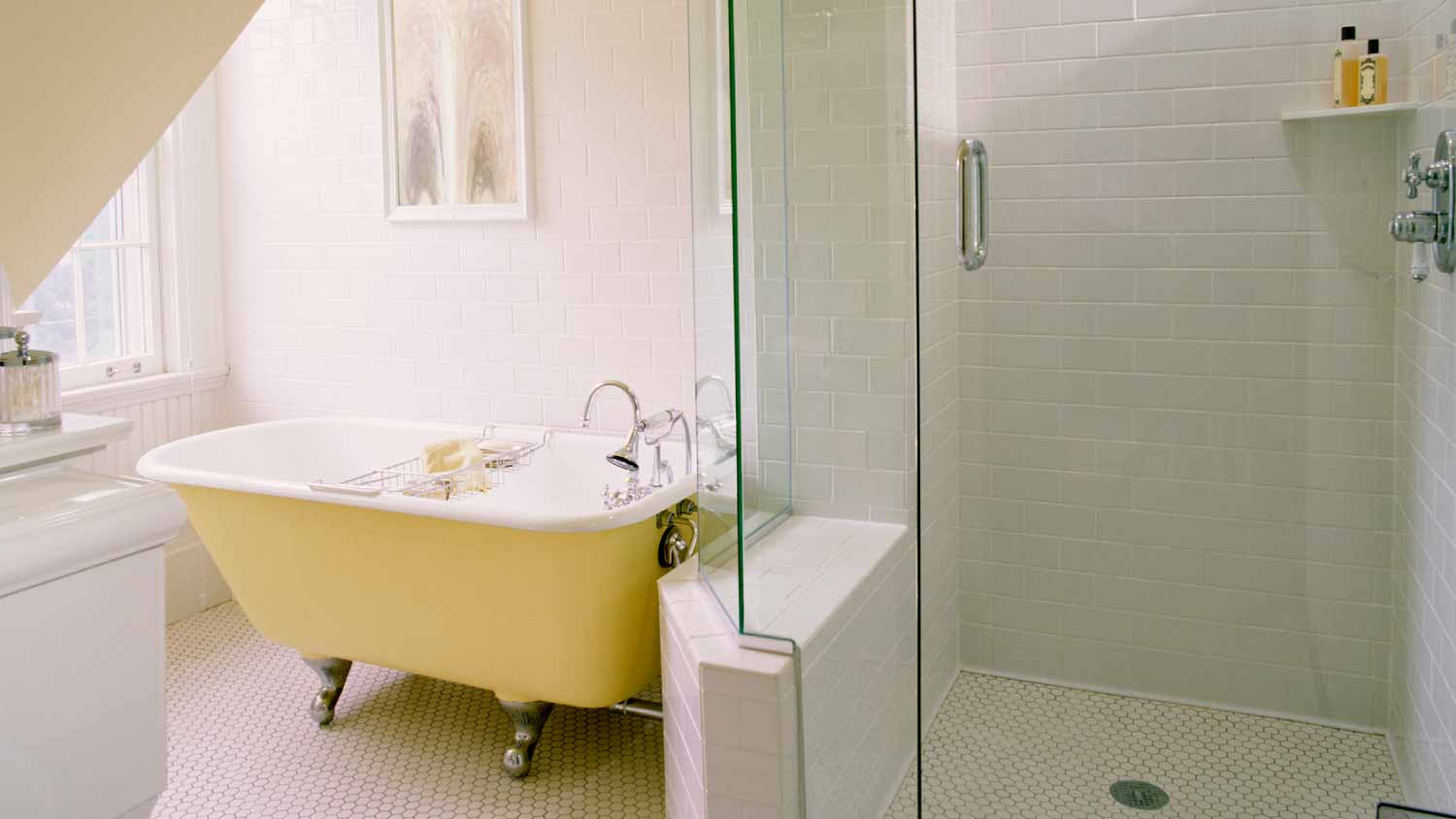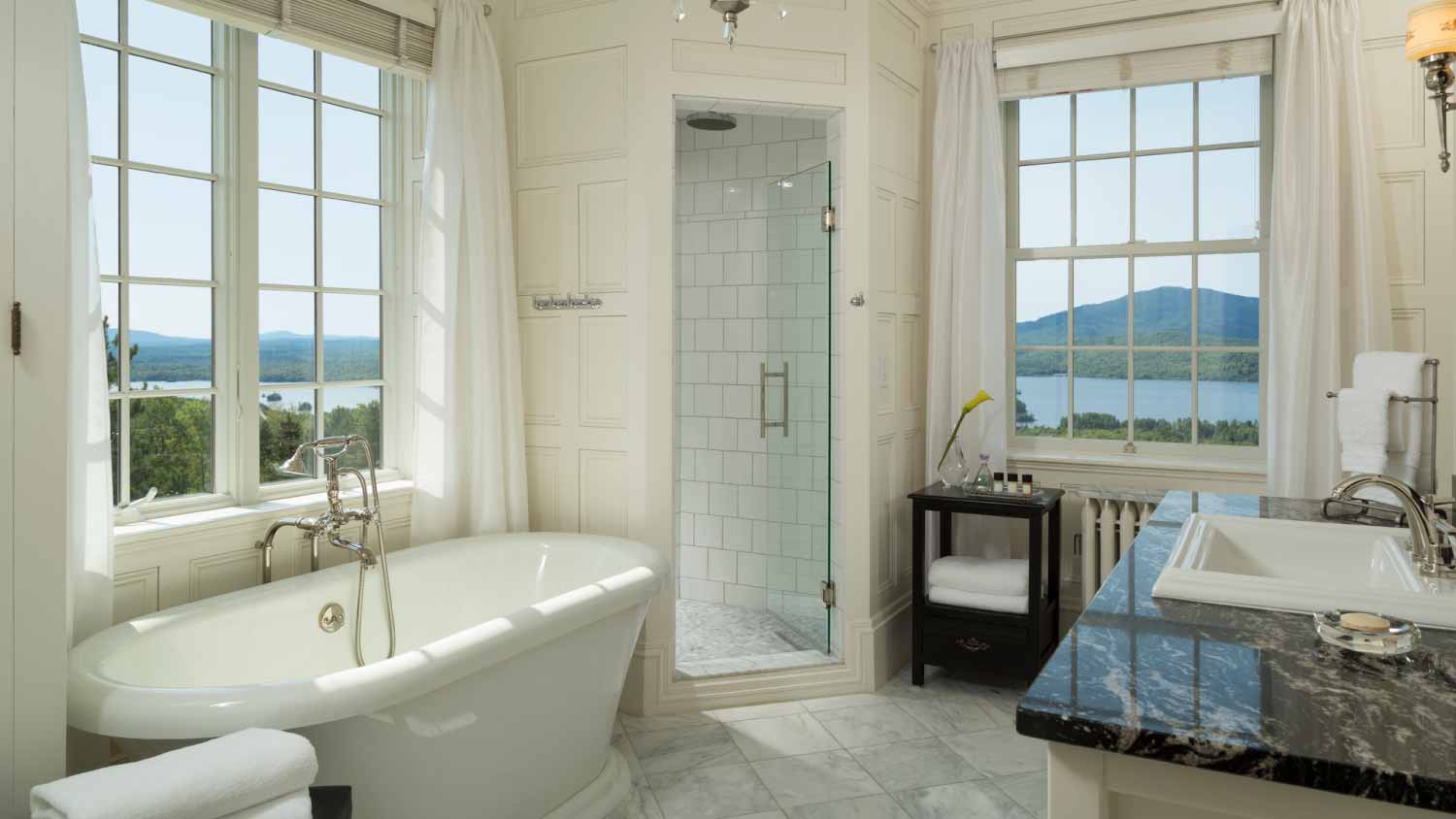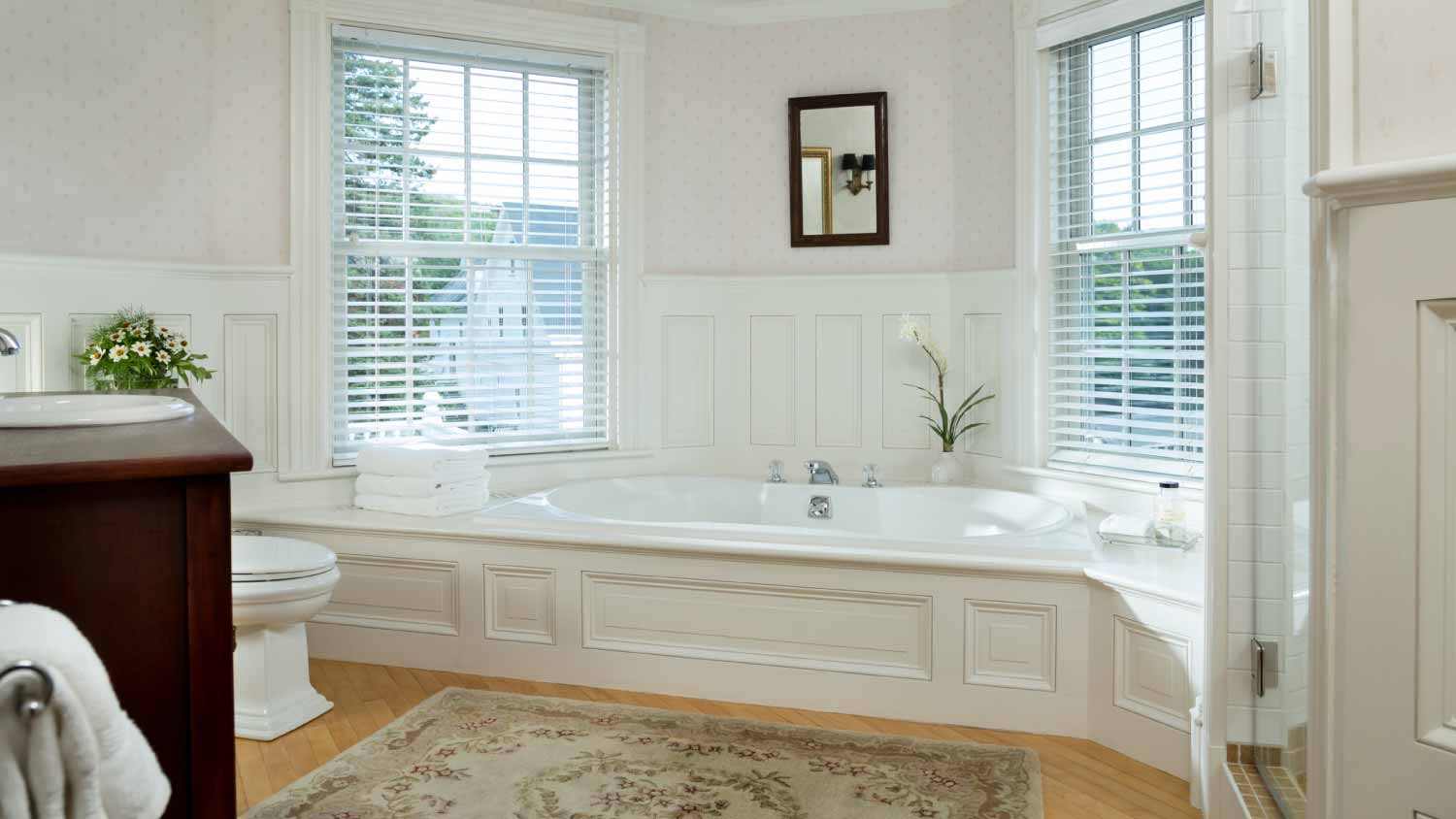
The cost of installing a bathtub or a shower liner depends on the type of tub or shower, size, and features. This guide will show what you can expect to pay for your project.
Traditional meets modern, yet always feels fresh


Transitional bathrooms blend two different design styles.
It’s the perfect balance between traditional vs. modern or contemporary.
Traditional elements can include clawfoot tubs, pedestal sinks, and rustic wood accents.
Modern accents can include frameless walk-in showers, slate tiling, and floating shelves.
Transitional bathrooms are trendy, but what are they? This design style is the best of both worlds, combining two elements from two different aesthetics. Typically, you’ll find that transitional bathrooms blend traditional design with contemporary or modern design. Considering the lofty cost of most bathroom remodels, it’s important to get the details right—and this guide will show you how to do it in your own home.
The key element of transitional bathrooms is that they mix two styles. Typically one style is more traditional or classic (think: clawfoot tubs), and the other is more modern (think: a shower with frameless glass doors). It’s a mix and match of old and new—whether you focus on fixtures, materials, or even accent decor.
Since a transitional bathroom is about blending two design styles, you can’t really go wrong with implementing it. But there are some common mistakes to try to avoid.
Avoid mixing too many different design styles. Transitional design works best when you pick up to two styles (for example, modern and rustic). Adding in a third or more will make it hard to balance and confusing on which design elements represent which era.
Less is more. Especially in a bathroom, you’ll want to avoid cluttering up your space with too much decor. Even utilitarian items like a shower door or sink can reflect a specific design aesthetic.
Lean towards neutrals. For big items like your wall color, tile selection, and countertop, neutrals will make it easier to fit in fixtures, lighting, and other decorative elements that reflect a specific style.
Transitional style is all about blending opposing bathroom design ideas. It doesn’t matter how you do it, just that you include elements of both. Here are some tips to help you incorporate this design style into your bathroom remodel.

Large items like sinks, showers, and tubs are the center of a bathroom, so they’re a great place to begin. For a transitional bathroom design, start with a tub that’s either traditional or modern—then layer it with elements from the opposing style. For big ticket items, try:
A porcelain, clawfoot tub (traditional)
A porcelain pedestal sink (traditional)
A shaker-style vanity (traditional)
A round, soaking tub (modern)
A frameless, glass shower (modern)
A free-standing double vanity (modern)
From there, the pairings begin. Your whole space should be a play between vintage-inspired elements and pieces that feel sleek and fresh.
You may think two different styles can’t go together, but it’s all about finding commonality. When choosing elements for your bathroom, look for items that suit either style but have a clear common denominator.
For example, a dark wood vanity is very traditional—especially if you choose one with a half-moon curve. Pair that with a curved walk-in shower. The shower feels modern, but the curves play off your vanity.
At the same time, traditional bathroom tiles are often square. Pair that with a modern, rectangular illuminated mirror. This keeps on the theme of right angles.

Traditional bathrooms tend to have more warm-toned elements, like rustic browns and beiges. Modern bathrooms often use more cool tones, like the full spectrum of gray. Transitional bathrooms can go either way—but as a rule, keep bathroom paint colors light, airy, and relaxing in this design style. Start with:
Whites
Creams
Beiges
Grays
If you want something bolder, never go bright; go rich. Deep green, chocolate, navy, and charcoal all feel elevated. Choose a calming sage, soft blue, or dusty rose for something more subtle that still involves a little color.
It’s easier to say what you won’t find in a transitional bathroom than what you will find. Mostly, the look is all about simplicity. It’s clean lines-meets-old styles; it’s classic-meets-chic.
Avoid ultra-heavy traditional furnishings or elaborate or highly embellished accents. Simple crown molding is fine, but opulent Victorian-inspired millwork is not. Also, avoid ultra-trendy decor. It should feel elegant and sophisticated.

Lighting can dress up a room; it’s almost like jewelry. For a transitional-style bathroom, you’ll need to choose either a traditional light fixture or something sleek and modern. You can mix and match, but for a simple idea, pick lighting in the opposite style of your shower or tub.
For example, try a sleek pendant light if you’ve got a clawfoot tub. If you have a modern walk-in shower, install an ultra-luxe chandelier.
Transitional bathroom design isn’t just about fixtures. You can get the look by playing with different materials. Think about your finishes: rose gold and chrome can feel very modern, while gold and copper have some vintage flair.
Additionally, pay attention to how you’re using materials. Choose traditional materials in modern silhouettes or vice versa. For example, both wood and marble are classic, but you can make them feel modern by choosing wooden floating shelving or using marble to top an ultra-sleek, wall-mounted floating vanity.

Bathrooms have a multitude of flooring options—and you can use them as an important accent. If your fixtures are modern, add rustic flooring. Go for classic wooden planks or ceramic tile. Leave any exposed wood beams. If your fixtures are traditional, reach for modern flooring. Installing slate tile averages $10 to $15 per square foot.
Accessories are one of the simplest ways to introduce any design style. Add an instant traditional feel to modern fixtures by hanging vintage artwork or lining your shelves with antique apothecary items. If you want to balance a traditional space, try hanging a bold modern art print or a digital wall clock. Don’t know where to start? Check out these bathroom decorating ideas for inspiration. Remember to keep it clean, not cluttered.
The majority of bathroom remodeling projects cost between $6,630 and $17,530, with an average cost of $12,000. The prices can vary dramatically based on how much prep work the homeowner does, and it’s easy for remodeling projects to cost more than $30,000 if you’re ripping out the tiles, fixtures, and flooring to be replaced with luxury materials.
Naturally, the prices will increase along with the size of the bathroom, with smaller half-bathroom remodels costing dramatically less than spacious rooms larger than 100 square feet. Expect around 20% of your overall remodeling budget to go toward labor.
Whether or not you can or should DIY your bathroom remodel depends primarily on the size of the project and your experience with home renovation projects. While most people with mid-level DIY experience could replace a vanity or faucet, switching out a shower or tub is beyond the skills of most homeowners—especially when plumbing or electrical are involved.
Doing the work yourself can save you a pretty penny, as a DIYer renovating a 40-square-foot bathroom could save between $1,500 and $5,300. But, contractors often find materials for lower costs and have the experience to make even smaller projects look their best. Beyond that, a contractor’s experience will ensure you don’t injure yourself or accidentally flood your bathroom.
If you’re doing any major improvements or don’t have the experience necessary to handle a plumbing or electrical job, call a local bathroom professional.
Mariel Loveland contributed to this article.
From average costs to expert advice, get all the answers you need to get your job done.

The cost of installing a bathtub or a shower liner depends on the type of tub or shower, size, and features. This guide will show what you can expect to pay for your project.

Remodeling your bathroom can add significant value to your home. Your bathroom remodel cost will depend on size, fixtures, materials, labor, and other factors.

The cost to add a half bathroom varies based on geography and your choice of additions. Read on to discover just what factors into your total project cost.

An updated bathtub can give a bathroom a whole new look. Find out how much it costs to replace a bathtub in Seattle, WA, including prices by type and labor costs.

DIY sink installation is a doozy but do-able for those with experience. Use this guide to learn how to install a bathroom sink in a few steps.

An updated bathtub can give a bathroom a whole new look. Find out how much it costs to replace a bathtub in Phoenix, AZ, including prices by type and labor costs.